Abstract
Background—Height of portal pressure correlates with severity of alcoholic cirrhosis. Portal pressure indices are not however used routinely as predictors of survival. Aims—To examine the clinical value of a single portal pressure measurement in predicting outcome in cirrhotic patients who have bled. Methods—A series of 105 cirrhotic patients who consecutively underwent hepatic venous pressure measurement were investigated. The main cause of cirrhosis was alcoholic (64.8%) and prior to admission all patients had bled from varices. Results—During the follow up period (median 566 days, range 10-2555), 33 patients died, and 54 developed variceal haemorrhage. Applying Cox regression analysis, hepatic venous pressure gradient, bilirubin, prothrombin time, ascites, and previous long term endoscopic treatment were the only statistically independent predictors of survival, irrespective of cirrhotic aetiology. The predictive value of the pressure gradient was much higher if the measurement was taken within the first or the second week from the bleeding and there was no association after 15 days. A hepatic venous pressure gradient of at least 16 mm Hg appeared to identify patients with a greatly increased risk of dying. Conclusions—Indirectly measured portal pressure is an independent predictor of survival in patients with both alcoholic and non-alcoholic cirrhosis. In patients with a previous variceal bleeding episode this predictive value seems to be better if the measurement is taken within the first two weeks from the bleeding episode. A greater use of this technique is recommended for the prognostic assessment and management of patients with chronic liver disease.
Keywords: chronic liver disease; alcoholic cirrhosis; portal pressure
Full Text
The Full Text of this article is available as a PDF (120.8 KB).
Figure 1 .
Hepatic venous pressure gradient versus Child-Pugh grade.
Figure 2 .
Cumulative death rate in relation to free hepatic venous pressure gradient (HVPG).
Selected References
These references are in PubMed. This may not be the complete list of references from this article.
- Braillon A., Cales P., Valla D., Gaudy D., Geoffroy P., Lebrec D. Influence of the degree of liver failure on systemic and splanchnic haemodynamics and on response to propranolol in patients with cirrhosis. Gut. 1986 Oct;27(10):1204–1209. doi: 10.1136/gut.27.10.1204. [DOI] [PMC free article] [PubMed] [Google Scholar]
- Conn H. O. A peek at the Child-Turcotte classification. Hepatology. 1981 Nov-Dec;1(6):673–676. doi: 10.1002/hep.1840010617. [DOI] [PubMed] [Google Scholar]
- Gluud C., Henriksen J. H., Nielsen G. Prognostic indicators in alcoholic cirrhotic men. Hepatology. 1988 Mar-Apr;8(2):222–227. doi: 10.1002/hep.1840080205. [DOI] [PubMed] [Google Scholar]
- Infante-Rivard C., Esnaola S., Villeneuve J. P. Clinical and statistical validity of conventional prognostic factors in predicting short-term survival among cirrhotics. Hepatology. 1987 Jul-Aug;7(4):660–664. doi: 10.1002/hep.1840070408. [DOI] [PubMed] [Google Scholar]
- Iwao T., Toyonaga A., Ikegami M., Sumino M., Oho K., Sakaki M., Shigemori H., Nakayama M., Tanikawa K. Wedged hepatic venous pressure reflects portal venous pressure during vasoactive drug administration in nonalcoholic cirrhosis. Dig Dis Sci. 1994 Nov;39(11):2439–2444. doi: 10.1007/BF02087663. [DOI] [PubMed] [Google Scholar]
- Krogsgaard K., Gluud C., Henriksen J. H., Christoffersen P. Correlation between liver morphology and portal pressure in alcoholic liver disease. Hepatology. 1984 Jul-Aug;4(4):699–703. doi: 10.1002/hep.1840040423. [DOI] [PubMed] [Google Scholar]
- Lebrec D., De Fleury P., Rueff B., Nahum H., Benhamou J. P. Portal hypertension, size of esophageal varices, and risk of gastrointestinal bleeding in alcoholic cirrhosis. Gastroenterology. 1980 Dec;79(6):1139–1144. [PubMed] [Google Scholar]
- Lin H. C., Tsai Y. T., Lee F. Y., Chang T. T., Wang S. S., Lay C. S., Lee S. D., Lo K. J. Comparison between portal vein pressure and wedged hepatic vein pressure in hepatitis B-related cirrhosis. J Hepatol. 1989 Nov;9(3):326–330. doi: 10.1016/0168-8278(89)90141-4. [DOI] [PubMed] [Google Scholar]
- Merkel C., Bolognesi M., Bellon S., Zuin R., Noventa F., Finucci G., Sacerdoti D., Angeli P., Gatta A. Prognostic usefulness of hepatic vein catheterization in patients with cirrhosis and esophageal varices. Gastroenterology. 1992 Mar;102(3):973–979. doi: 10.1016/0016-5085(92)90185-2. [DOI] [PubMed] [Google Scholar]
- Picchiotti R., Mingazzini P. L., Scucchi L., Bressan M., Di Stefano D., Donnetti M., Feroci L. Correlations between sinusoidal pressure and liver morphology in cirrhosis. J Hepatol. 1994 Mar;20(3):364–369. doi: 10.1016/s0168-8278(94)80009-x. [DOI] [PubMed] [Google Scholar]
- Polio J., Groszmann R. J. Hemodynamic factors involved in the development and rupture of esophageal varices: a pathophysiologic approach to treatment. Semin Liver Dis. 1986 Nov;6(4):318–331. doi: 10.1055/s-2008-1040614. [DOI] [PubMed] [Google Scholar]
- Pugh R. N., Murray-Lyon I. M., Dawson J. L., Pietroni M. C., Williams R. Transection of the oesophagus for bleeding oesophageal varices. Br J Surg. 1973 Aug;60(8):646–649. doi: 10.1002/bjs.1800600817. [DOI] [PubMed] [Google Scholar]
- Reichen J. MEGX test in hepatology: the long-sought ultimate quantitative liver function test? J Hepatol. 1993 Aug;19(1):4–7. doi: 10.1016/s0168-8278(05)80169-2. [DOI] [PubMed] [Google Scholar]
- Villanueva C., Balanzó J., Novella M. T., Soriano G., Sáinz S., Torras X., Cussó X., Guarner C., Vilardell F. Nadolol plus isosorbide mononitrate compared with sclerotherapy for the prevention of variceal rebleeding. N Engl J Med. 1996 Jun 20;334(25):1624–1629. doi: 10.1056/NEJM199606203342502. [DOI] [PubMed] [Google Scholar]
- Vinel J. P., Cassigneul J., Levade M., Voigt J. J., Pascal J. P. Assessment of short-term prognosis after variceal bleeding in patients with alcoholic cirrhosis by early measurement of portohepatic gradient. Hepatology. 1986 Jan-Feb;6(1):116–117. doi: 10.1002/hep.1840060122. [DOI] [PubMed] [Google Scholar]
- Vorobioff J., Groszmann R. J., Picabea E., Gamen M., Villavicencio R., Bordato J., Morel I., Audano M., Tanno H., Lerner E. Prognostic value of hepatic venous pressure gradient measurements in alcoholic cirrhosis: a 10-year prospective study. Gastroenterology. 1996 Sep;111(3):701–709. doi: 10.1053/gast.1996.v111.pm8780575. [DOI] [PubMed] [Google Scholar]




